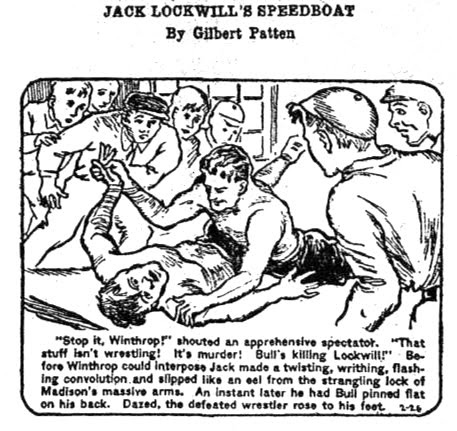'Jack Lockwill's Adventures'.
Larry Redner was an American cartoonist, who worked on several features for the Newspaper Enterprise Association during the 1920s. He originated the children's picture story serials 'The Tinymites' (1926-1927) and 'Jack Lockwill's Adventures' (1927), and worked on biography/adaptation strips such as 'The Romance of America' (1926-1927), 'Poe's Stories' (1926) and 'Ivanhoe' (1926). Among the few actual balloon comics by Redner are 'The Little Old Wise Man' (1921-1922), 'Bucky the Little Old Man' (1926-1929) and 'Tobey and Tyke' (drawn in the second half of the 1920s).
Early life and career
Lawrence W. Redner was born in 1884 in Cleveland, Ohio, into a family of Russian immigrants. He held several odd jobs before becoming a commercial artist and cartoonist, operating from his own Redner Studio. Between February 1915 and March 1918 he worked as a sports cartoonist for the Cleveland Plain Dealer. By the 1920s he was living in Akron, Cleveland, and active as an artist in the rubber works industry. Around this time he also turned to syndicated cartoons. For the Ad Art Service, Redner made the comic strip 'The Little Old Wise Man' (1921-1922). Basically an advertising strip, it starred an elderly man whose solution for every problem was placing a classified ad in the newspaper.
'The Tinymites', from The Capital Times, 4 November 1926.
Adventure picture stories
For the rest of the decade, Larry Redner was affiliated with the Newspaper Enterprise Association (NEA), where he worked on many text comic features (picture stories with the text written underneath the images). He was initially paired with writer/art director Hal Cochran for a couple of fantasy-flavored children's picture stories. Starting on 12 March 1924, he succeeded Lee Wright as the illustrator of 'Jack Daw's Adventures', which he continued until it ended on 22 April 1926. Later that year, Cochran and Redner originated another picture story serial, called 'The Tinymites'. The feature, about a group of kids who engage in all kinds of magical adventures, consisted of one single illustration with a text written in rhyme. The Tinymite's names refer to their respective roles or appearances: Clowny is a clown, Scouty a boy scout, Coppy "plays" a cop, and Dotty wears a dotted dress, etc. Readers were encouraged to read the story and then color the picture. After Redner's departure on 8 January 1927, 'The Tinymites' was illustrated by Irving S. Knickerbocker (1927-1930), Joe King (1930-1932) and George Scarbo (1933-1935). In the same tradition, Larry Redner drew the 'Jack Lockwill's Adventures' stories written by Gilbert Patten during the first six months of 1927, until George Clark took over.
'Poe's Stories' (The Sheboygan Press, 3 September 1926).
Biographical comics and adaptations
Redner was also the original illustrator of 'The Romance of America' (1926-1927), a series of biographical picture stories about important persons from American history, written by Bill Brauch. Redner's illustrations livened up the stories of General Custer, Molly Pitcher, Thomas Jefferson, Barbara Fritchie, Robert Fulton, the Swamp Fox, Stephen Decatur, and Aaron Burr. This feature was temporarily replaced by 'Poe's Stories' (July-September 1926), where Braucher and Redner adapted eight Edgar Allan Poe stories to the picture story format. They then resumed 'The Romance of America', until Redner passed the pencil to, subsequently, Paul Kroesen, Loron Taylor and P.V. Bressey. Larry Redner also adapted Walter Scott's 'Ivanhoe' into a daily comic strip between 23 April and 3 June 1926.
Balloon comics and cartoons
Lawrence Redner also worked on a handful of balloon comics. His 'Bucky the Little Old Man' was a topper strip for Merrill Blosser's 'Freckles and his Friends' Sunday comic, and ran between 24 October 1926 and 30 June 1929. Between 1925 and 1929 Redner had his own weekly strip called 'Tobey and Tyke', about a quick-witted kid and his rather destructive dog. Another feature that Redner worked on was the single panel cartoon 'Little Joe Says' (1925-1926). It presented a daily cartoon of a cross between a kid and a middle-aged man, accompanied by a wisecrack caption. It was originally drawn by an artist called Storm in 1924-1925 (which might have been a pen name for Redner). When Redner left, it was taken over by Irving S. Knickerbocker between 1926 and 1930.
Later life
Larry Redner eventually moved to Detroit, Michigan, where he continued to work as a newspaper artist. It is unknown when he passed away.







